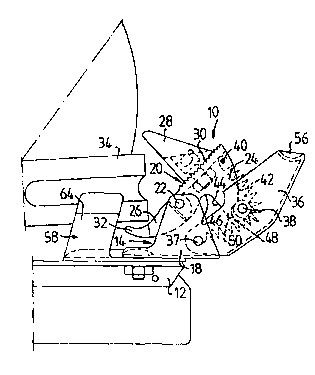Some of the information on this Web page has been provided by external sources. The Government of Canada is not responsible for the accuracy, reliability or currency of the information supplied by external sources. Users wishing to rely upon this information should consult directly with the source of the information. Content provided by external sources is not subject to official languages, privacy and accessibility requirements.
Any discrepancies in the text and image of the Claims and Abstract are due to differing posting times. Text of the Claims and Abstract are posted:
| (12) Patent Application: | (11) CA 2175468 |
|---|---|
| (54) English Title: | SKATE HEEL BINDING |
| (54) French Title: | DISPOSITIF DE FIXATION D'UN PATIN A GLACE AU TALON D'UNE BOTTINE DE PATINAGE |
| Status: | Deemed Abandoned and Beyond the Period of Reinstatement - Pending Response to Notice of Disregarded Communication |
| (51) International Patent Classification (IPC): |
|
|---|---|
| (72) Inventors : |
|
| (73) Owners : |
|
| (71) Applicants : | |
| (74) Agent: | NORTON ROSE FULBRIGHT CANADA LLP/S.E.N.C.R.L., S.R.L. |
| (74) Associate agent: | |
| (45) Issued: | |
| (86) PCT Filing Date: | 1994-10-31 |
| (87) Open to Public Inspection: | 1995-05-11 |
| Availability of licence: | N/A |
| Dedicated to the Public: | N/A |
| (25) Language of filing: | English |
| Patent Cooperation Treaty (PCT): | Yes |
|---|---|
| (86) PCT Filing Number: | PCT/SE1994/001020 |
| (87) International Publication Number: | WO 1995012439 |
| (85) National Entry: | 1996-04-30 |
| (30) Application Priority Data: | ||||||
|---|---|---|---|---|---|---|
|
The present invention relates to a heel binding
(10) for a skate (12) and comprises a heel lock mech-
anism with a vertically pivotable locking member (20),
arranged, in an actuated position, to be in contact with
an edge portion of the top of the heel (34) of a skater's
boot, and in a non-actuated position to be pivoted back-
wards away from the heel. The locking mechanism (20)
is bifurcated and has a lower linkage arm (26) actuated
by the heel and an upper locking arm (24) fixing the
heel. An operating arm (36) is vertically pivotable adja-
cent the locking member (20) and supports a cam roller
(38), which is resiliently biassed against a cam profile
(44) on the rear edge of the locking arm, by means of
a spring (42).
L'invention porte sur un dispositif de fixation (10) d'un patin à glace (12) au talon d'une bottine, comprenant un mécanisme de verrouillage muni d'un élément de verrouillage pivotant verticalement (20) et conçu pour se trouver, en position d'accouplement, en contact avec une partie marginale supérieure du talon (34) de la bottine du patineur, et en position libérée, basculé en arrière de façon à s'écarter du talon. Le mécanisme de verrouillage (20) en forme de fourche présente un bras de liaison inférieur (26) actionné par le talon et un bras supérieur de verrouillage (24) fixant le talon. Un bras d'actionnement (36) pivote de façon à venir en contact avec l'élément de verrouillage (20), ce bras étant muni d'un galet de came (38) sollicité par un ressort (42) sur un profil de came (44) situé sur le bord arrière du bras de verrouillage.
Note: Claims are shown in the official language in which they were submitted.
Note: Descriptions are shown in the official language in which they were submitted.

2024-08-01:As part of the Next Generation Patents (NGP) transition, the Canadian Patents Database (CPD) now contains a more detailed Event History, which replicates the Event Log of our new back-office solution.
Please note that "Inactive:" events refers to events no longer in use in our new back-office solution.
For a clearer understanding of the status of the application/patent presented on this page, the site Disclaimer , as well as the definitions for Patent , Event History , Maintenance Fee and Payment History should be consulted.
| Description | Date |
|---|---|
| Inactive: IPC assigned | 2022-10-18 |
| Inactive: IPC assigned | 2022-10-18 |
| Inactive: IPC expired | 2012-01-01 |
| Inactive: IPC from MCD | 2006-03-12 |
| Application Not Reinstated by Deadline | 2002-10-31 |
| Time Limit for Reversal Expired | 2002-10-31 |
| Inactive: Abandon-RFE+Late fee unpaid-Correspondence sent | 2001-10-31 |
| Deemed Abandoned - Failure to Respond to Maintenance Fee Notice | 2001-10-31 |
| Application Published (Open to Public Inspection) | 1995-05-11 |
| Abandonment Date | Reason | Reinstatement Date |
|---|---|---|
| 2001-10-31 |
The last payment was received on
Note : If the full payment has not been received on or before the date indicated, a further fee may be required which may be one of the following
Please refer to the CIPO Patent Fees web page to see all current fee amounts.
| Fee Type | Anniversary Year | Due Date | Paid Date |
|---|---|---|---|
| MF (application, 3rd anniv.) - small | 03 | 1997-10-31 | 1997-10-09 |
| MF (application, 4th anniv.) - small | 04 | 1998-11-02 | 1998-10-27 |
| MF (application, 5th anniv.) - small | 05 | 1999-11-01 | 1999-10-25 |
| MF (application, 6th anniv.) - small | 06 | 2000-10-31 | 2000-10-17 |
| MF (application, 2nd anniv.) - small | 02 | 1996-10-31 |
Note: Records showing the ownership history in alphabetical order.
| Current Owners on Record |
|---|
| HARALD ALMGREN AB |
| Past Owners on Record |
|---|
| BENGT JOHANSSON |